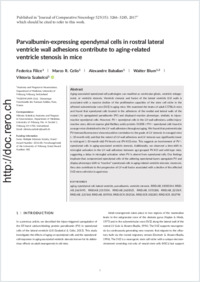Parvalbumin-expressing ependymal cells in rostral lateral ventricle wall adhesions contribute to aging-related ventricle stenosis in mice
- Filice, Federica Anatomy and Program in Neuroscience, Department of Medicine, University of Fribourg, Switzerland
- Celio, Marco R. Anatomy and Program in Neuroscience, Department of Medicine, University of Fribourg, Switzerland
- Babalian, Alexandre Anatomy and Program in Neuroscience, Department of Medicine, University of Fribourg, Switzerland
- Blum, Walter Anatomy and Program in Neuroscience, Department of Medicine, University of Fribourg, Switzerland - INSERM UMR-1162, Génomique Fonctionelle des Tumeurs Solides, Paris, France
- Szabolcsi, Viktoria Anatomy and Program in Neuroscience, Department of Medicine, University of Fribourg, Switzerland
-
15.10.2017
Published in:
- Journal of Comparative Neurology. - 2017, vol. 525, no. 15, p. 3266–3285
Aging
Ependymal cell
Lateral ventricle
Parvalbumin
Ventricle stenosis
RRID:AB_10000344
RRID:AB_2665495
RRID:AB_2315304
RRID:AB_2620025
RRID:AB_1555288
RRID:AB_221569
RRII
English
Aging-associated ependymal-cell pathologies can manifest as ventricular gliosis, ventricle enlargement, or ventricle stenosis. Ventricle stenosis and fusion of the lateral ventricle (LV) walls is associated with a massive decline of the proliferative capacities of the stem cell niche in the affected subventricular zone (SVZ) in aging mice. We examined the brains of adult C57BL/6 mice and found that ependymal cells located in the adhesions of the medial and lateral walls of the rostral LVs upregulated parvalbumin (PV) and displayed reactive phenotype, similarly to injury-reactive ependymal cells. However, PV+ ependymal cells in the LV-wall adhesions, unlike injury-reactive ones, did not express glial fibrillary acidic protein. S100B+/PV+ ependymal cells found in younger mice diminished in the LV-wall adhesions throughout aging. We found that periventricular PV-immunofluorescence showed positive correlation to the grade of LV stenosis in nonaged mice (<10-month-old), and that the extent of LV-wall adhesions and LV stenosis was significantly lower in mid- aged (>10-month-old) PV-knock out (PV-KO) mice. This suggests an involvement of PV+ ependymal cells in aging-associated ventricle stenosis. Additionally, we observed a time-shift in microglial activation in the LV-wall adhesions between age-grouped PV- KO and wild-type mice, suggesting a delay in microglial activation when PV is absent from ependymal cells. Our findings implicate that compromised ependymal cells of the adhering ependymal layers upregulate PV and display phenotype shift to “reactive” ependymal cells in aging-related ventricle stenosis; moreover, they also contribute to the progression of LV-wall fusion associated with a decline of the affected SVZ-stem cell niche in aged mice.
- Faculty
- Faculté des sciences et de médecine
- Department
- Département de Médecine
- Language
-
- English
- Classification
- Biological sciences
- License
-
License undefined
- Identifiers
-
- RERO DOC 305740
- DOI 10.1002/cne.24276
- Persistent URL
- https://folia.unifr.ch/unifr/documents/305989
Statistics
Document views: 112
File downloads:
- pdf: 315
